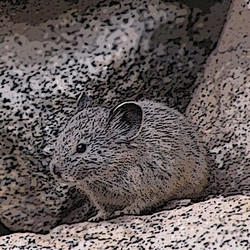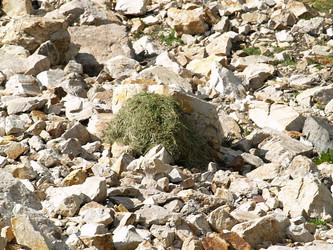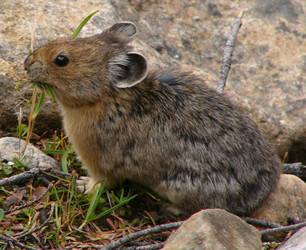Once upon a time, on a Rocky Mountain slope far away from the big city, lived a young pika named Pik-a-CHOO! Though his friends would have called him Pik, if he had friends.


Pika near rocky burrow. © Justin Johnsen. Modified by John Mains.
Pik lived with his mother in a large community of pikas high in the Rockies. They shared a burrow hidden in the rocks of the boulder field, above the tree line. Their burrow was connected to other burrows with a system of tunnels, the whole community was connected.
Pik had a troubled childhood because his mother ran of with a gopher when he was only 50 days old, just when he was fully grown. Since pikas only live for three years you’d think that they wouldn’t have the time for such drama, but nooooo! They DO!
When his mother first left Pik was very lonely and cried himself to sleep, it was loud and annoying. The Snow finch that shared his burrow became so annoyed that he left, and the rest of the pika closed off the tunnels connecting Pik’s burrow to the rest of the community. He felt even more alone.
Pik had to stop crying and be an adult male pika, so he had to sing so he could get a wife. So standing at the front of his burrow, he sang with all his might but he was terribly flat and didn’t get asked to go to Hollywood, so he cursed Simon and refused to talk to Ryan when he came out of his audition, but that’s beside the point. Even the pikas singing as barbershop quartet got more girls then him, 4! Well that’s not that amazing seeing as there were four of them. But Pik got none, zip, zero, nothing!
Because he had no success in his singing career, he had nothing else to do but start his haystack. As soon as he had a pile, other pikas started to steal hay, so to fend them off he had to yell at them, but like his singing, this wasn't his strong suit. While protecting his haystack, Pik claimed the hearing of 36 pikas because his yelling was so high pitched. By the time his haystacking was over, his pile was a mere 16 cm wide by 20 cm high, compared to others that were over 1/2 meter high.


A pika hastack, ~12cm high. © Chrharshaw
During this time of haystacking Pik was occasionally called to hiding by the rest of the community, because predators like eagles or foxes where seen. Pik never would go into hiding with much speed because he was so depressed he didn't care about the predators.
Thankfully, due to the colours of his coat he blends into the rocks, and he doesn’t really have to worry too much about the predators seeing him.
It was January when Pik ran out of hay, he had to find a way to get more food. He decided to venture out into the snow and wind to find more food. Pik prepared to go outside in the snow by doing cardio and lifting weights. He put on weight to stay warm, and he was ready. He put one paw outside and said:
“No! Too cold, I’ll find more in spring.”
“Well what about food, young Pik?” questioned the narrator,
“Well, I’ll just steal hay from the other Pikas. Wait what are you doing here, there’s no narrator in my story!” said Pik.
Pik squeaked and bit the narrator on the toe.
You thought the story would continue with Pik out in the cold, HA! I got you!
By the spring time Pik was tired of eating lichen and cushion plants, so he headed out to find some kind of food. But because the snow was just about gone all he had to eat were lichen and cushion plants. Instead of chewing it and dealing with the taste, he just rolled the lichen into little balls and swallowed it.
It was late April when Pik heard about his mother. Pik was sunning himself on a the rock looking over the community, when he heard two pikas below him talking;
“Did you hear about Pik’s mom?” one said,
“No, what?” replied the other,
“The heat got her, as soon she left the mountain the temperature was nearly 23°C.”
“Oh no!”
“Yup gone within an hour”
Upon hearing this Pik decided that mourning the loss wasn’t an option, at the tender age of 1, a third of his life was gone. The cycle had to continue.
The End
Pika Facts
Names:
- Ochotona princeps
- American Pika
Description: The pika is a small animal similar in appearance to a hamster. It has a small, round, egg-shaped body, round ears, short limbs, and an extremely short tail. The American Pika is usually 16-20 cm in length, and weighs an average of 170 grams. Its coat is most often a bland dark gray interspersed with brown. White fur is prominent on the chest and belly, and there is a distinctive solid gray patch on the shoulder and neck. They have sharp curved claws, padded toes, and excellent hearing and vision.
Habitat: The American Pika lives in the mountains of the Western US and Canada. In the mountains, the pika lives above the tree line (8,000 – 13,000 feet) in rock fields. As they live in communities, their burrows, in the cracks between the rocks, are mostly interconnected.
Adaptations: To live through the alpine winter, because they do not hibernate, the pikas gather food, grasses mostly, to store for the winter. This is called haystacking, because the grasses they collect are piled up to dry, then moved to their dens for the winter. Their coat also provides protection from predators because of its salt and pepper appearance which allows it to blend into the rocks.
Life cycle: Pikas live for approximately 3 years, and are able to breed at 1 year of age. Their annual life cycle begins in spring with the breeding season. The pika breeding season peaks in late May/early June, which is still early spring in their mountain habitats. Unlike other animals, pikas’ territoriality is at its lowest during the breeding season. Male pikas sing to female pikas, and after a 30 day gestation period, 2-6 hairless, blind infants are born. Female pikas will have a second litter of 2-6 immediately after the first, and will raise all of their offspring by themselves. Young pikas reach adult size after only 40-50 days. There are no distinct familial groups within pika populations. Since pikas live in communities composed of many–often connected–burrows, young pikas may continue to inhabit the same burrow as their mother, even after reaching maturity. Once breeding season is over, pika communities become frenziedly active. They begin to accumulate as many plants as they can, eating a small portion whenever they find food, and putting the rest into partially concealed locations to dry. These piles of vegetation can become extremely large haystacks, reaching as high as 2 feet and also 2 feet in diameter. During summer, haymaking is the pikas’ dominant activity. At this time, pikas become extremely territorial and defensive of their haystacks, squeaking loudly at neighbors attempting to steal their hay. A different type of squeak, however, will warn the entire community of a predator and send them all scurrying into their rocky burrows. When winter comes, pikas bring all of their haystacks into their burrows, and will usually not re-emerge until spring. Since they do not hibernate, pikas’ survival depends on the success of their hay-making. After months of snow, the pikas emerge and the cycle begins again.
Classification:
- Kingdom – Animalia
- Phylum – Chordata
- Class – Mammalia
- Order – Lagomorpha
- Family – Ochotonidae
- Genus – Ochotona
- Species – Ochotona princeps
Conservation Status: Though the American Pika status is Least Concern, the population has been found to be declining. The main threat for the pika is global warming, because the warmer it gets the higher the pikas must go on the mountain, because when the temperature reaches at least 23°C the pika can die within an hour. Thus the species is used as an early warning for global warming in the Western US and Canada. If global warming persists the pika is in serious threat of extinction.




 Go to quick links
Go to quick search
Go to navigation for this section of the ToL site
Go to detailed links for the ToL site
Go to quick links
Go to quick search
Go to navigation for this section of the ToL site
Go to detailed links for the ToL site